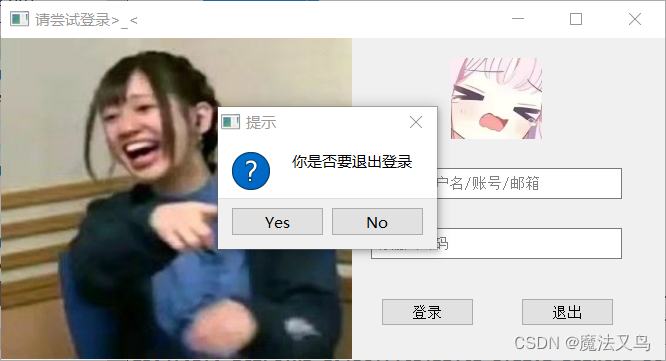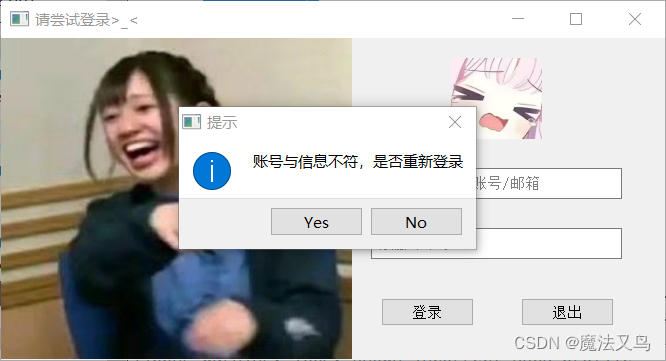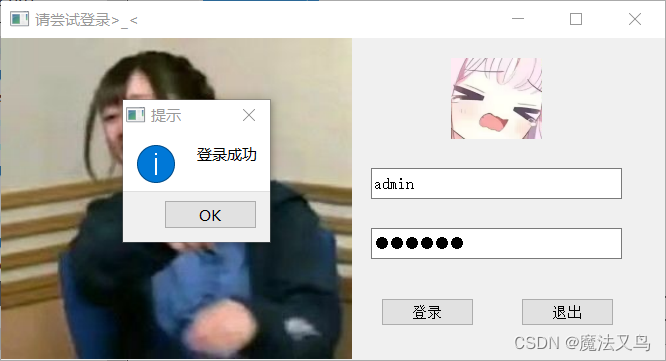-
QTday3
- #include "widget.h"
- #include "ui_widget.h"
- Widget::Widget(QWidget *parent)
- : QWidget(parent)
- , ui(new Ui::Widget)
- {
- ui->setupUi(this);
- this->setWindowTitle("请尝试登录>_<");
- ui->name->setPlaceholderText("请输入用户名/账号/邮箱");
- ui->password->setPlaceholderText("请输入密码");
- ui->password->setEchoMode(QLineEdit::Password);//密码不可见
- this->connect(ui->btn2,SIGNAL(clicked()),this,SLOT(on_btn2()));//qt4退出
- connect(ui->btn1,&QPushButton::clicked,this,&Widget::on_btn1);//qt5登录
- }
- Widget::~Widget()
- {
- delete ui;
- }
- void Widget::on_btn1()
- {
- if(ui->name->text()=="admin" && ui->password->text()=="123456")
- {
- QMessageBox msg(
- QMessageBox::Information,//图标
- "提示",//对话框标题
- "登录成功",//对话框文本
- QMessageBox::Ok,//提供按钮
- this);//父对象
- int ret = msg.exec();//exec()函数执行对话框
- if(ret == QMessageBox::Ok)//按钮判断
- {
- this->close();
- emit jump();
- }
- }
- else
- {
- QMessageBox msg1(
- QMessageBox::Information,
- "提示",
- "账号与信息不符,是否重新登录",
- QMessageBox::Yes | QMessageBox::No,
- this);
- int ret1 = msg1.exec();
- if(ret1 == QMessageBox::Yes)
- {
- ui->password->clear();
- }
- else if(ret1 == QMessageBox::No)
- {
- this->close();
- }
- }
- }
- void Widget::on_btn2()
- {//静态成员函数调用
- int ret2 = QMessageBox::question(this,
- "提示",
- "你是否要退出登录",
- QMessageBox::Yes | QMessageBox::No);
- if(ret2 == QMessageBox::Yes)
- {
- this->close();
- }
- }
- #ifndef WIDGET_H
- #define WIDGET_H
- #include
- #include
- #include
- #include
- QT_BEGIN_NAMESPACE
- namespace Ui { class Widget; }
- QT_END_NAMESPACE
- class Widget : public QWidget
- {
- Q_OBJECT
- public:
- Widget(QWidget *parent = nullptr);
- ~Widget();
- signals://信号函数
- void jump();
- public slots://公共的槽函数
- private slots:
- void on_btn1();
- void on_btn2();
- private:
- Ui::Widget *ui;
- QPushButton *btn1;
- QPushButton *btn2;
- };
- #endif // WIDGET_H
- #include "form.h"
- #include "ui_form.h"
- Form::Form(QWidget *parent) :
- QWidget(parent),
- ui(new Ui::Form)
- {
- ui->setupUi(this);
- }
- Form::~Form()
- {
- delete ui;
- }
- void Form::jumpSlot()
- {
- this->show();
- }
- #ifndef FORM_H
- #define FORM_H
- #include
- namespace Ui {
- class Form;
- }
- class Form : public QWidget
- {
- Q_OBJECT
- public:
- explicit Form(QWidget *parent = nullptr);
- ~Form();
- public slots:
- void jumpSlot();
- private:
- Ui::Form *ui;
- };
- #endif // FORM_H



-
相关阅读:
Matlab神经网络工具箱——一个例子搞定神经网络算法
YOLO7 姿势识别实例
一、CSS盒子模型[外边距、内边距、box-sizing、边框、轮廓线]
QT使用sqllite
训练专门化的大型语言模型(LLM)现在更简单了
按标记分组写成多文件
v-model
构建未来:利用服务器打造个性化创意项目和在线社区
使用wireshark解析ipsec esp包
Masonry系列之网格瀑布流加载动画特效
- 原文地址:https://blog.csdn.net/m0_73912044/article/details/133933519
